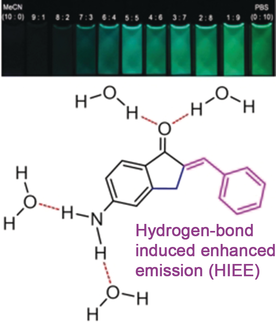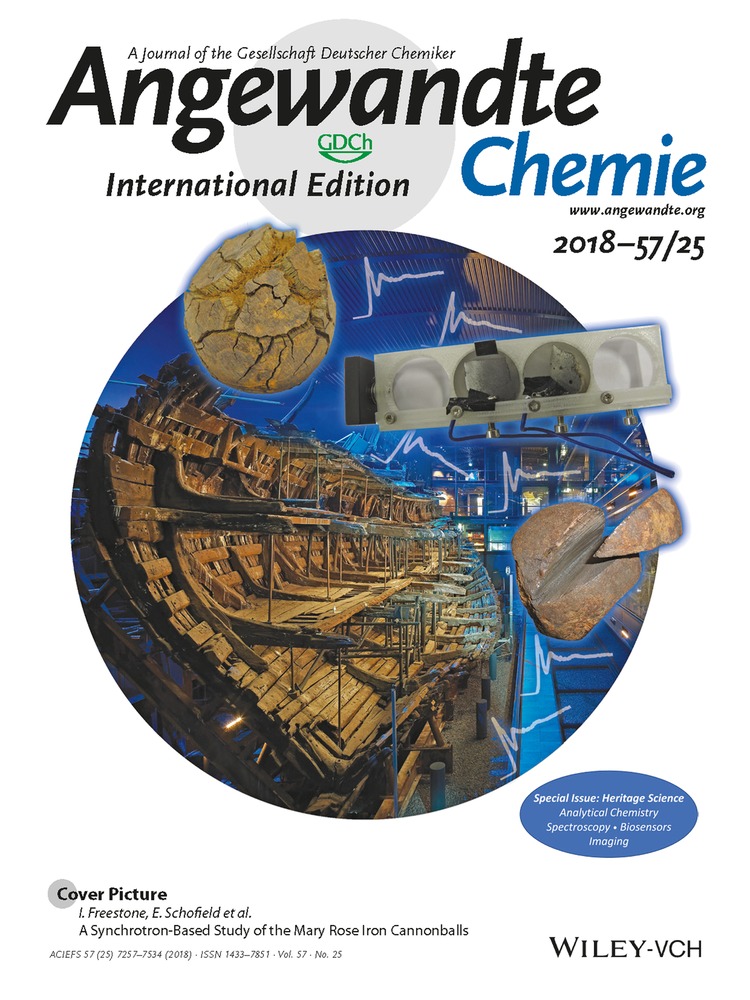Enhancing the Anti-Solvatochromic Two-Photon Fluorescence for Cirrhosis Imaging by Forming a Hydrogen-Bond Network
Tian-Bing Ren
State Key Laboratory of Chemo/Biosensing and Chemometrics, College of Chemistry and Chemical Engineering, Hunan University, Changsha, 410082 P. R. China
These authors contributed equally to this work.
Search for more papers by this authorDr. Wang Xu
State Key Laboratory of Chemo/Biosensing and Chemometrics, College of Chemistry and Chemical Engineering, Hunan University, Changsha, 410082 P. R. China
These authors contributed equally to this work.
Search for more papers by this authorQian-Ling Zhang
State Key Laboratory of Chemo/Biosensing and Chemometrics, College of Chemistry and Chemical Engineering, Hunan University, Changsha, 410082 P. R. China
Search for more papers by this authorXing-Xing Zhang
State Key Laboratory of Chemo/Biosensing and Chemometrics, College of Chemistry and Chemical Engineering, Hunan University, Changsha, 410082 P. R. China
Search for more papers by this authorSi-Yu Wen
State Key Laboratory of Chemo/Biosensing and Chemometrics, College of Chemistry and Chemical Engineering, Hunan University, Changsha, 410082 P. R. China
Search for more papers by this authorDr. Hai-Bo Yi
State Key Laboratory of Chemo/Biosensing and Chemometrics, College of Chemistry and Chemical Engineering, Hunan University, Changsha, 410082 P. R. China
Search for more papers by this authorCorresponding Author
Prof. Dr. Lin Yuan
State Key Laboratory of Chemo/Biosensing and Chemometrics, College of Chemistry and Chemical Engineering, Hunan University, Changsha, 410082 P. R. China
Search for more papers by this authorProf. Dr. Xiao-Bing Zhang
State Key Laboratory of Chemo/Biosensing and Chemometrics, College of Chemistry and Chemical Engineering, Hunan University, Changsha, 410082 P. R. China
Search for more papers by this authorTian-Bing Ren
State Key Laboratory of Chemo/Biosensing and Chemometrics, College of Chemistry and Chemical Engineering, Hunan University, Changsha, 410082 P. R. China
These authors contributed equally to this work.
Search for more papers by this authorDr. Wang Xu
State Key Laboratory of Chemo/Biosensing and Chemometrics, College of Chemistry and Chemical Engineering, Hunan University, Changsha, 410082 P. R. China
These authors contributed equally to this work.
Search for more papers by this authorQian-Ling Zhang
State Key Laboratory of Chemo/Biosensing and Chemometrics, College of Chemistry and Chemical Engineering, Hunan University, Changsha, 410082 P. R. China
Search for more papers by this authorXing-Xing Zhang
State Key Laboratory of Chemo/Biosensing and Chemometrics, College of Chemistry and Chemical Engineering, Hunan University, Changsha, 410082 P. R. China
Search for more papers by this authorSi-Yu Wen
State Key Laboratory of Chemo/Biosensing and Chemometrics, College of Chemistry and Chemical Engineering, Hunan University, Changsha, 410082 P. R. China
Search for more papers by this authorDr. Hai-Bo Yi
State Key Laboratory of Chemo/Biosensing and Chemometrics, College of Chemistry and Chemical Engineering, Hunan University, Changsha, 410082 P. R. China
Search for more papers by this authorCorresponding Author
Prof. Dr. Lin Yuan
State Key Laboratory of Chemo/Biosensing and Chemometrics, College of Chemistry and Chemical Engineering, Hunan University, Changsha, 410082 P. R. China
Search for more papers by this authorProf. Dr. Xiao-Bing Zhang
State Key Laboratory of Chemo/Biosensing and Chemometrics, College of Chemistry and Chemical Engineering, Hunan University, Changsha, 410082 P. R. China
Search for more papers by this authorGraphical Abstract
Turn bane into a boon: A unique class of two-photon dyes with anti-solvatochromic fluorescence, optically tunable groups, high fluorescence quantum yields, and large two-photon action cross sections in water are developed. Their use for in vivo imaging, was demonstrated in the monitoring of endogenous H2S generation and scavenging in the cirrhotic rat liver.
Abstract
Two-photon imaging is an emerging tool for biomedical research and clinical diagnostics. Electron donor–acceptor (D–A) type molecules are the most widely employed two-photon scaffolds. However, current D–A type fluorophores suffer from solvatochromic quenching in aqueous biological samples. To address this issue, we devised a novel class of D–A type green fluorescent protein (GFP) chromophore analogues that form a hydrogen-bond network in water to improve the two-photon efficiency. Our design results in two-photon chalcone (TPC) dyes with 0.80 quantum yield and large two-photon action cross section (210 GM) in water. This strategy to form hydrogen bonds can be generalized to design two-photon materials with anti-solvatochromic fluorescence. To demonstrate the improved in vivo imaging, we designed a sulfide probe based on TPC dyes and monitored endogenous H2S generation and scavenging in the cirrhotic rat liver for the first time.
Supporting Information
As a service to our authors and readers, this journal provides supporting information supplied by the authors. Such materials are peer reviewed and may be re-organized for online delivery, but are not copy-edited or typeset. Technical support issues arising from supporting information (other than missing files) should be addressed to the authors.
| Filename | Description |
|---|---|
| anie201800293-sup-0001-misc_information.pdf6.4 MB | Supplementary |
Please note: The publisher is not responsible for the content or functionality of any supporting information supplied by the authors. Any queries (other than missing content) should be directed to the corresponding author for the article.
References
- 1
- 1aX. Chen, F. Wang, J. Y. Hyun, T. Wei, J. Qiang, X. Ren, I. Shin, J. Yoon, Chem. Soc. Rev. 2016, 45, 2976–3016;
- 1bA. T. Aron, K. M. Ramos-Torres, J. A. Cotruvo, C. J. Chang, Acc. Chem. Res. 2015, 48, 2434–2442;
- 1cZ. Yang, J. Cao, Y. He, J. H. Yang, T. Kim, X. Peng, J. S. Kim, Chem. Soc. Rev. 2014, 43, 4563–4601;
- 1dW. Xu, Z. Zeng, J. H. Jiang, Y. T. Chang, L. Yuan, Angew. Chem. Int. Ed. 2016, 55, 13658–13699; Angew. Chem. 2016, 128, 13858–13902.
- 2H. M. Kim, B. R. Cho, Chem. Rev. 2015, 115, 5014–5055.
- 3
- 3aD. Kim, H. Moon, S. H. Baik, S. Singha, Y. W. Jun, T. Wang, K. H. Kim, B. S. Park, J. Jung, I. Mook-Jung, K. H. Ahn, J. Am. Chem. Soc. 2015, 137, 6781–6789;
- 3bT. Ren, W. Xu, F. Jin, D. Cheng, L. Zhang, L. Yuan, X. Zhang, Anal. Chem. 2017, 89, 11427–11434;
- 3cE. D. Cosco, J. R. Caram, O. T. Bruns, D. Franke, R. A. Day, E. P. Farr, M. G. Bawendi, E. M. Sletten, Angew. Chem. Int. Ed. 2017, 56, 13126–13129; Angew. Chem. 2017, 129, 13306–13309.
- 4
- 4aS. Singha, D. Kim, B. Roy, S. Sambasivan, H. Moon, A. S. Rao, J. Y. Kim, T. Joo, J. W. Park, Y. M. Rhee, T. Wang, K. H. Kim, Y. H. Shin, J. Jung, K. H. Ahn, Chem. Sci. 2015, 6, 4335–4342;
- 4bE. Kim, Y. Lee, S. Lee, S. B. Park, Acc. Chem. Res. 2015, 48, 538–547;
- 4cE. Yamaguchi, C. Wang, A. Fukazawa, M. Taki, Y. Sato, T. Sasaki, M. Ueda, N. Sasaki, T. Higashiyama, S. Yamaguchi, Angew. Chem. Int. Ed. 2015, 54, 4539–4543; Angew. Chem. 2015, 127, 4622–4626.
- 5H. M. Kim, C. Jung, B. R. Kim, S. Y. Jung, J. H. Hong, Y. G. Ko, K. J. Lee, B. R. Cho, Angew. Chem. Int. Ed. 2007, 46, 3460–3463; Angew. Chem. 2007, 119, 3530–3533.
- 6
- 6aY. J. Gong, X. B. Zhang, G. J. Mao, L. Su, H. M. Meng, W. Tan, S. Feng, G. Zhang, Chem. Sci. 2016, 7, 2275–2285;
- 6bM. Sun, K. Mullen, M. Yin, Chem. Soc. Rev. 2016, 45, 1513–1528.
- 7
- 7aH. R. Naughton, C. J. Abelt, J. Phys. Chem. B 2013, 117, 3323–3327;
- 7bJ. Catalan, Handbook of Solvents, 2nd ed., ChemTec Publishing, Oxford, 2014, pp. 581–622.
10.1016/B978-1-895198-64-5.50016-7 Google Scholar
- 8
- 8aV. G. Machado, R. I. Stock, C. Reichardt, Chem. Rev. 2014, 114, 10429–10475;
- 8bY. Yang, D. Li, C. Li, Y. Liu, K. Jiang, Spectrochim. Acta Part A 2017, 187, 68–74.
- 9
- 9aX. Liu, Q. Qiao, W. Tian, W. Liu, J. Chen, M. J. Lang, Z. Xu, J. Am. Chem. Soc. 2016, 138, 6960–6963;
- 9bJ. B. Grimm, B. P. English, J. Chen, J. P. Slaughter, Z. Zhang, A. Revyakin, R. Patel, J. J. Macklin, D. Normanno, R. H. Singer, T. Lionnet, L. D. Lavis, Nat. Methods 2015, 12, 244–250.
- 10
- 10aA. O. Doroshenko, M. D. Bilokin, V. G. Pivovarenko, J. Photochem. Photobiol. A 2004, 163, 95–102;
- 10bR. Englman, J. Jortner, Mol. Phys. 1970, 18, 145–164.
- 11M. Staniforth, W. D. Quan, T. N. V. Karsili, L. A. Baker, R. K. O'Reilly, V. G. Stavros, J. Phys. Chem. A 2017, 121, 6357–6365.
- 12S. Lee, K. K. Y. Yuen, K. A. Jolliffe, J. Yoon, Chem. Soc. Rev. 2015, 44, 1749–1762.
- 13
- 13aL. M. Oltrogge, S. G. Boxer, ACS Cent. Sci. 2015, 1, 148–156;
- 13bM. Drobizhev, N. S. Makarov, S. E. Tillo, T. E. Hughes, A. Rebane, Nat. Methods 2011, 8, 393–399.
- 14
- 14aD. Zhai, W. Xu, L. Zhang, Y. T. Chang, Chem. Soc. Rev. 2014, 43, 2402–2411;
- 14bJ. Mei, N. L. C. Leung, R. T. K. Kwok, J. W. Y. Lam, B. Z. Tang, Chem. Rev. 2015, 115, 11718–11940.
- 15
- 15aG. Cui, Z. Lan, W. Thiel, J. Am. Chem. Soc. 2012, 134, 1662–1672;
- 15bY. Li, T. Liu, H. Liu, M. Z. Tian, Y. Li, Acc. Chem. Res. 2014, 47, 1186–1198.
- 16J. L. Wallace, R. Wang, Nat. Rev. Drug Discovery 2015, 14, 329–345.
- 17S. Mani, W. Cao, L. Wu, R. Wang, Nitric Oxide 2014, 41, 62–71.
- 18E. G. Giannini, R. Testa, V. Savarino, Can. Med. Assoc. J. 2005, 172, 367–379.
- 19
- 19aS. Fiorucci, E. Antonelli, A. Mencarelli, S. Orlandi, B. Renga, G. Rizzo, E. Distrutti, V. Shah, A. Morelli, Hepatology 2005, 42, 539–548;
- 19bN. Zhang, Y. Zheng, W. Chen, R. Li, L. Song, L. Xu, K. Xu, J. Huazhong Univ. Sci. Technol. Med. Sci. 2017, 37, 705–710.





